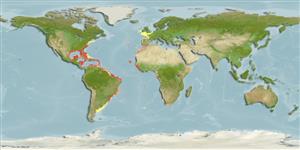>
Anguilliformes (Eels and morays) >
Muraenidae (Moray eels) > Muraeninae
Etymology: Gymnothorax: Greek, gymnos = naked + Greek, thorax, -akos = breast (Ref. 45335).
More on author: Castelnau.
Environment: milieu / climate zone / depth range / distribution range
Écologie
marin récifal; profondeur ? - 145 m (Ref. 5288). Subtropical
Western Atlantic: Bermuda, southern Florida (USA), and the Bahamas to Brazil. Eastern Atlantic: Azores, Madeira, the Canary Islands, Cape Verde, and islands of Bay of Biafra (Ref. 4450); Ascension I. (Ref. 98447).
Taille / Poids / Âge
Maturity: Lm ? range ? - ? cm
Max length : 132 cm TL mâle / non sexé; (Ref. 104752); common length : 70.0 cm TL mâle / non sexé; (Ref. 5217); poids max. publié: 750.00 g (Ref. 40637)
Description synthétique
Morphologie | Morphométrie
Mottled greenish or brown overall, often with darker flecks. Anal and caudal fins have white margins that continue onto rear third and sometimes entire length of dorsal fin (Ref. 26938).
A benthic and solitary species (Ref. 26340) inhabiting rocky shores and reefs where water is clear. Most active at night (Ref. 9710). Marketed fresh (Ref. 5217). May cause serious wounds (Ref. 5217). Traded as an aquarium fish at Ceará, Brazil (Ref. 49392).
Life cycle and mating behavior
Maturité | Reproduction | Frai | Œufs | Fécondité | Larves
Robins, C.R. and G.C. Ray, 1986. A field guide to Atlantic coast fishes of North America. Houghton Mifflin Company, Boston, U.S.A. 354 p. (Ref. 7251)
Statut dans la liste rouge de l'IUCN (Ref. 130435)
Menace pour l'homme
Traumatogenic (Ref. 5217)
Utilisations par l'homme
Pêcheries: intérêt commercial mineur; Aquarium: Commercial
Plus d'informations
Noms communsSynonymesMétabolismePrédateursÉcotoxicologieReproductionMaturitéFraiRassemblement de ponteFéconditéŒufsDéveloppement de l'œuf
RéférencesAquacultureProfil d'aquacultureSouchesGénétiqueElectrophoresesHéritabilitéPathologiesTraitementNutrientsMass conversion
Outils
Articles particuliers
Télécharger en XML
Sources Internet
Estimates based on models
Preferred temperature (Ref.
123201): 19.5 - 27.9, mean 25.4 °C (based on 660 cells).
Phylogenetic diversity index (Ref.
82804): PD
50 = 0.5000 [Uniqueness, from 0.5 = low to 2.0 = high].
Bayesian length-weight: a=0.00058 (0.00037 - 0.00089), b=3.26 (3.14 - 3.38), in cm total length, based on LWR estimates for this species & Genus-body shape (Ref.
93245).
Niveau trophique (Ref.
69278): 4.3 ±0.6 se; based on diet studies.
Résilience (Ref.
120179): Très faible, temps minimum de doublement de population supérieur à 14 ans (Preliminary K or Fecundity.).
Fishing Vulnerability (Ref.
59153): Very high vulnerability (79 of 100).
Nutrients (Ref.
124155): Calcium = 13.6 [6.8, 27.0] mg/100g; Iron = 0.444 [0.240, 0.866] mg/100g; Protein = 19.4 [17.2, 21.9] %; Omega3 = 0.167 [0.069, 0.494] g/100g; Selenium = 27.6 [13.1, 57.0] μg/100g; VitaminA = 49.7 [14.0, 179.5] μg/100g; Zinc = 0.486 [0.319, 0.734] mg/100g (wet weight);
